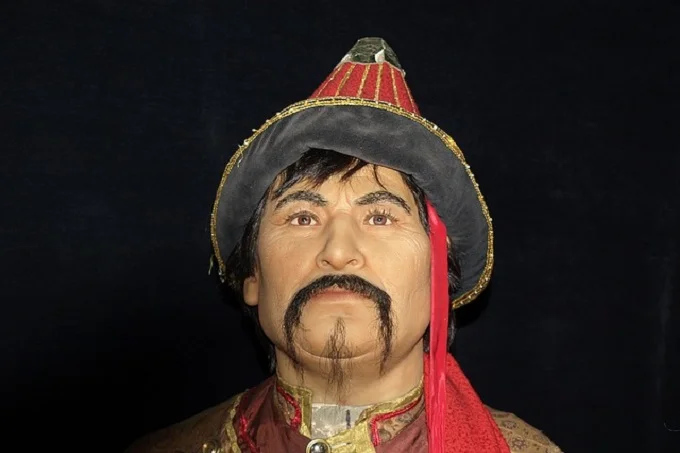Throughout human history, in many cultures, preserving the remains of famous people has been considered vital for religious, cultural, or political reasons. Moreover, the graves of celebrities usually have symbolic value and become a place of worship for their admirers and followers. However, their burial sites are not always known. This happens for various reasons – over the years, the grave’s location is lost, forgotten, and sometimes intentionally hidden, remaining unknown.
8 famous personalities whose graves cant be found
1. Genghis Khan

Legend has it that Genghis Khan, the Great commander and founder of the Mongol Empire, ordered his subjects to hide all traces of his burial place after his death. Presumably, he died in 1227 during his campaign in China, and his son sent the body to Mongolia.
The soldiers fulfilled Genghis Khan’s last request, carefully hiding the grave. Thousands of horse riders trampled this place, redirecting the riverbed through it. After that, everyone who saw the funeral of the commander was killed so that no one could reveal the secret of his burial.
The traveler Marco Polo wrote that even by the end of the 13th century, the Mongols did not know the tomb’s location. Since then, dozens of expeditions have been sent to search for Genghis Khan’s burial site, but they have failed. Although historians suggest that his body found its final resting place in the Khentii mountain range in Mongolia, the grave of the founder of the Mongolian Empire has not been found to this day.
2. Tecumseh
Tecumseh, an Indian leader of the Shawnee tribe, who formed a coalition of indigenous groups of Indians in resistance to the American settlement of the territories of Ohio and Indiana and united his warriors with the British during the War of 1812, died during the battle on the Thames. According to eyewitnesses, his body was picked up by soldiers and buried near the battlefield.
There are no records of the exact location of Tecumseh’s grave, which is believed to be in what is now Ontario. Visit. A F R I N I K . C O M . For the full article. However, the indigenous Shawnee people think that it doesn’t matter. It’s important for them that the dead “make the journey” or allow the body to decompose, creating nutrients in the soil and thus allowing the life cycle to continue.
Shawnees sometimes visit the battlefield and leave a tobacco offering there. They know where the battle took place, so the entire battlefield is considered a sacred place for them. Moreover, the authorities know that if archaeologists or anyone else tries to find and disturb Tecumseh’s remains, protests may break out.
3. Caligula
One of the most brutal Roman emperors, Caligula, was assassinated by a detachment of his guards just four years after he ascended the throne. It happened in his palace on the Palatine Hill in 41 AD.
After his death, his body was moved outside Rome to the Lamian Gardens, where it was cremated, and his ashes were placed in a temporary grave under a light layer of turf. There were legends that his ghost roamed the Lamian Gardens for a long time until his ashes were buried correctly. Caligula’s grave was not revered in ancient Rome, so his final resting place was lost over time.
In 2011, the Italian police announced they had found Emperor Caligula’s lost tomb. This happened after the arrest of a man who tried to load a statue of the Roman emperor found near Lake Nemi into a truck, where the emperor’s last burial place could be located. However, the archaeologists who excavated there did not find evidence that the emperor’s tomb was there.
4. Alexander the Great
The king of Ancient Macedonia and an outstanding commander of antiquity died in Babylon in 323 BC after a ten-year campaign of conquerors from Greece to India. He was initially buried in a golden sarcophagus in Egypt, and later, his ashes were transferred to Alexandria.
The tomb of Alexander the Great was treated almost like a temple of God. Roman emperors such as Caesar and Augustus visited it, but it was repeatedly robbed. Even the golden sarcophagus was melted down and replaced with a glass one. In 190 AD, Emperor Septimius Severus ordered the sealing of the tomb, but this did not protect it from the destruction caused by wars, earthquakes, and tsunamis.
Over time, the tomb’s location was lost, and numerous searches were unsuccessful. It may have been moved to another location, although most historians believe it is still in Alexandria.
5. Eric I of Denmark
One of Denmark’s most beloved monarchs, King Eric Eyegod, who was called Eric the Good, died in Paphos in southwestern Cyprus in 1103 after he and his wife, Queen Bodil, went on a pilgrimage to the Holy Land, reaching Cyprus via Russia, the Black Sea, and Constantinople.
He became the only monarch outside Denmark; most others are buried in Roskilde Cathedral. Historians still have not agreed on the exact location of the king’s grave. It is believed that it is located in lower Paphos in the early Christian basilica of Agia Kyriaki Chrysopolitissa, or the nearby Latin Cathedral situated in the west on the opposite side of St. Paul Avenue, or, according to one theory, in Stavrovouni Monastery – one of the most ancient and revered monasteries in eastern Cyprus.
However, the fact that King Eric the Good died in Paphos on his way to the Holy Land is not disputed. Near the church of Agia Kyriaki, there is a memorial plaque marking the death of King Eric Eyegod.
6. Atahualpa
Atahualpa was the last Inca emperor. He fought a short but fierce civil war with his brother Huascar to control his Empire. Atahualpa won the Battle of Quito, but on his way back to the Inca capital of Cuzco, he was captured by the men of the Spanish conquistador Francisco Pizarro. He was held hostage for ransom and then brutally murdered.
The story goes that Atahualpa was initially buried in Cajamarca, where he was captured, but his followers later removed his body and reburied it in a secret location. Since then, the main search has been to find the hidden treasures of the Inca Empire. Spaniards have been searching for gold and silver hidden by the Incas for decades, although many historians believe these treasures never existed.
The exact location of Atahualpa’s grave is unknown to this day. In addition, historians question whether his body could have been taken out from under the Spaniards’ noses and reburied somewhere else. The Spaniards knew that even a dead Atahualpa could be dangerous to them, becoming a symbol of resistance to the enemy.
7. Alfred the Great
Alfred the Great was king of Wessex from 871 to 899 and was famous for defeating the Danish Vikings who invaded and settled in Britain. He is considered one of the most fabulous kings in the history of England. He began the process of uniting it at a time when, instead of a single state, there were many small kingdoms, often at war with each other. This process was completed by his grandson Athelstan, who became the first king of a united England.
After his death, King Alfred the Great was buried in the Anglo-Saxon Cathedral in Winchester, known as the Old Minster, but later, his son Edward the Elder moved his remains to the new New Minster Church. In 1110, the New Minster was moved to Hyde, which became Hyde Abbey, where all the royal burials were also moved.
The dissolution of the monasteries in the 16th century led to the dismantling of Hyde Abbey, which was turned into a prison. According to eyewitnesses, the tombs were emptied, and the remains scattered and destroyed. However, at the end of the 19th century, the antiquarian John Mellor reported that he had unearthed the bones of the royal family of Wessex on the site of the former Hyde Abbey. He claimed that he had given them to the rector of St. Bartholomew’s Church in Hyde, who had reburied the remains in an unmarked grave. However, this grave has not yet been found.
8. Leonardo da Vinci
The great Italian painter, Leonardo da Vinci, died in 1519 while serving Francis I of France and was buried in the chapel of Saint Florentine in the royal castle of Amboise in the Loire Valley. However, during the French Revolution, the chapel was destroyed, and the tomb with the artist’s remains was considered lost.
A group of archaeologists working at the site in 1874 discovered the remains, which should have belonged to Da Vinci. They reburied them in another chapel on the territory of St. Hubert’s Church. The memorial plaque indicates the artist’s “presumed” resting place. However, it is still unknown whether these remains belong to Da Vinci.
Genetic testing specialists from the Institute of J. Craig Venter in California are examining the artist’s work for traces of skin, hair, or fingerprints that could belong to a Renaissance master to conduct comparative DNA analysis.
